The 1912 Wheat Penny is one of the early coins in the Lincoln cent series, introduced in 1909. Now over a century old, it is considered a collectible antique. While pennies were once inexpensive to produce, today their manufacturing cost has risen to nearly three cents per coin!
Let’s explore the 1912 penny’s value, history, and the key factors that influence its worth.
1912 Penny Value Chart (Regular Strikes)
| Coin Type | EF/XF 45 | MS 60 | MS 64 | MS 65 | MS 66 | MS 67 |
|---|---|---|---|---|---|---|
| 1912-D Penny (Brown) | $115 | $225 | $400 | $675 | $1,800 | – |
| 1912-D Penny (Red-Brown) | – | $225 | $525 | $1,000 | $2,000 | – |
| 1912-D Penny (Red) | – | $250 | $1,000 | $1,200 | $6,000 | $70,000 |
| 1912-S Penny (Brown) | $85 | $225 | $500 | $950 | $2,600 | – |
| 1912-S Penny (Red-Brown) | – | $225 | $600 | $1,300 | $2,600 | – |
| 1912-S Penny (Red) | – | $315 | $950 | $2,400 | $18,000 | – |
| 1912 (P) No Mint Mark (Brown) | $24 | $44 | $125 | $275 | $375 | – |
| 1912 (P) No Mint Mark (Red-Brown) | – | $50 | $140 | $425 | $550 | $5,000 |
| 1912 (P) No Mint Mark (Red) | – | $65 | $325 | $525 | $1,300 | $5,350 |
1912 Matte Proof Penny Value Chart
| Coin Type | PR/PF 60 | PR/PF 62 | PR/PF 64 | PR/PF 66 | PR/PF 66+ | PR/PF 67 |
|---|---|---|---|---|---|---|
| 1912 (P) No Mint Mark Matte Proof (Brown) | $400 | $485 | $1,000 | $3,250 | $4,250 | $7,250 |
| 1912 (P) No Mint Mark Matte Proof (Red-Brown) | $475 | $550 | $1,050 | $3,500 | $11,500 | – |
| 1912 (P) No Mint Mark Matte Proof (Red) | $475 | $625 | $1,950 | $30,000 | – | – |
Factors That Influence the 1912 Penny’s Value
- Color: Red (RD) pennies are the most valuable, followed by Red-Brown (RB) and then Brown (BN).
- Condition: Higher-grade coins (MS 65 and above) sell for significantly more.
- Mint Mark: Denver (D) and San Francisco (S) mint coins tend to be rarer than those from Philadelphia (P).
- Proof Strikes: Matte proof pennies, made for collectors, command premium prices in higher grades.
History of the 1912 Penny
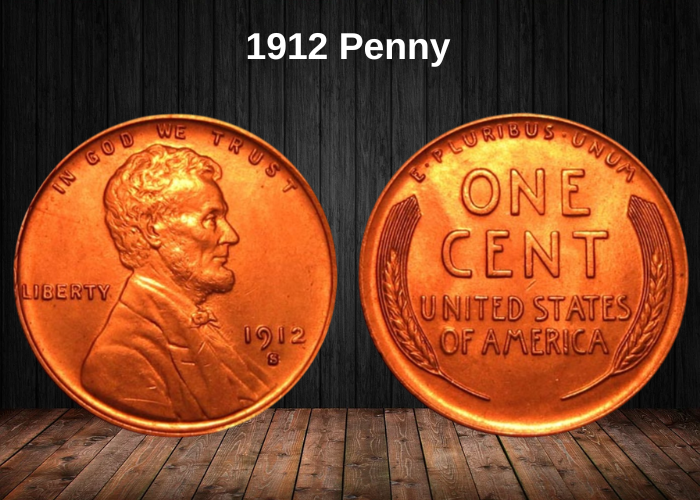
The design of pennies in the 1900s was a major departure from earlier versions. While the shift to a smaller size and copper composition had already begun in the 1850s, it wasn’t until 1909 that a formalized new style was introduced. This change was largely influenced by President Theodore Roosevelt’s dissatisfaction with the aesthetics of American currency. With strong connections to the art world, he shared the belief that US coins should have a more refined and artistic appearance.
Roosevelt was a driving force behind the decision to bring in external sculptors to revamp coin designs. The first artist commissioned for this task was Augustus Saint-Gaudens, who was responsible for redesigning the Eagle ($10 gold coin) and Double Eagle ($20 gold coin). However, at the time of his appointment, he was already battling terminal cancer. Sadly, he passed away before he could complete all the coin projects assigned to him.
To ensure the penny redesign moved forward, the US Mint turned to Victor David Brenner, who had previously worked as an assistant to Saint-Gaudens and was well-acquainted with his artistic philosophy. Brenner had also recently created an Abraham Lincoln plaque for Gorham Manufacturing, making him an ideal choice to design the new penny, which was meant to honor the 100th anniversary of Lincoln’s birth.
Features of the 1912 Penny
In numismatics, the front side of a coin is known as the obverse, while the back side is called the reverse. The thin side of the coin is referred to as the edge, which often features a raised border known as the rim or collar. In some cases, this edge is textured with small ridges called reeds.
The inscriptions found on a coin are known as mottos or legends, while the central images are called devices. The flat, unmarked areas surrounding these elements are known as the field. Before a coin is struck, it begins as a blank metal disc called a planchet.
The Obverse of the 1912 Penny
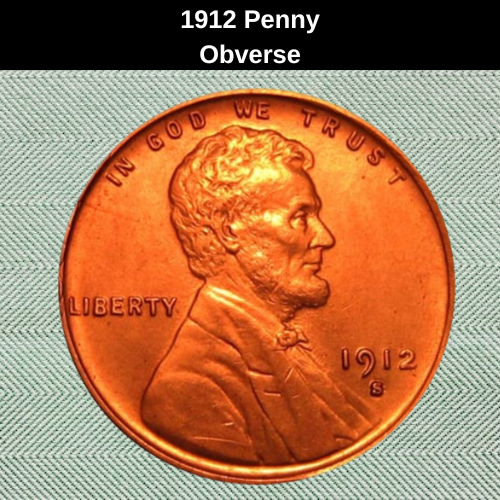
The obverse of the 1912 Penny features a right-facing portrait of President Abraham Lincoln. Above his head, the national motto “In God We Trust” is inscribed, while the word “Liberty” is positioned behind his back. In front of Lincoln’s chest, the minting date and mint mark (if present) are displayed.
Some Lincoln cents include the sculptor’s initials on Lincoln’s shoulder cut-off, identifying Victor David Brenner as the designer. However, this signature is absent on the 1912 Penny.
The Reverse of the 1912 Penny
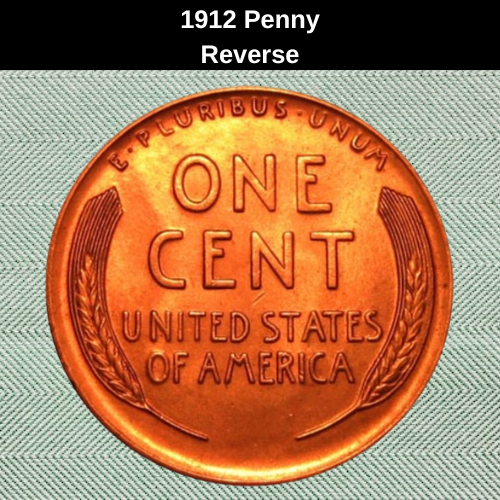
The reverse of the 1912 Penny features two stalks of durum wheat, symmetrically positioned along the left and right rims. At the top, there is a gap between the wheat tips, where the Latin motto “E Pluribus Unum” is inscribed.
Centered between the two wheat stalks, the coin’s denomination, “One Cent,” is prominently displayed. Just below, the inscription “United States of America” further identifies the issuing country.
Other Features of the 1912 Penny
The 1912 Lincoln Wheat Cent was composed of 95% copper, with the remaining 5% consisting of zinc, tin, or a combination of both. This small percentage of additional metals helped strengthen the coin and slowed the natural green patina that develops on pure copper over time.
Each 1912 Penny has a diameter of 19.05mm (0.75 inches), a weight of 3.11g, and a smooth, non-reeded edge. Pennies minted in Philadelphia do not bear a mint mark and are simply referred to as 1912 (P) coins.
1912 Penny Grading Guides
With older coins, determining a high grade is often straightforward—the shinier and newer it looks, the better the grade!
For pennies, in addition to their Sheldon Scale grade (ranging from 1 to 70), their condition is also classified by color:
- Red (RD) – Highest value, well-preserved with original luster
- Reddish-Brown (RB) – Mid-tier value, partial luster with some toning
- Brown (BN or BRN) – Lower value, heavily circulated with oxidation
It’s also essential to check for any scratches, nicks, or other imperfections, as they can impact the coin’s final grade.
Sheldon Coin Grading Scale Overview
| Grade | Description |
|---|---|
| 1 | Basal State-1 |
| 2 | Fair |
| 3 | Very Fair |
| 4, 5, 6 | Good |
| 7, 8, 10 | Very Good |
| 12, 15 | Fine |
| 20, 30 | Very Fine |
| 40 | Extremely Fine |
| 50 | About Uncirculated |
| 60 | Mint State |
| 65 | Mint State |
| 70 | Perfect Mint State |
For accurate valuation, refer to professional grading guides to assess your coin’s precise condition before determining its market worth.
1912 Penny Value Guides
Over the years, the US Mint has operated various branches, each with specific roles in coin production. Some branches specialized in producing gold coins, while others were later dedicated to minting proof coins. The mint where a coin is produced can have a significant impact on its market value, as certain mints are more highly regarded by collectors due to their lower mintage or unique features.
In 1912, pennies were struck at three different mints:
- Philadelphia (P): The main mint for regular coin production, and at this time, it was also responsible for producing proof coins.
- Denver (D): Known for striking coins with lower mintage numbers, making higher-grade pieces from Denver more valuable.
- San Francisco (S): San Francisco produced coins with distinct characteristics, and higher-quality specimens from this mint are often worth more.
Generally, coins from San Francisco and Denver are seen as rarer than those from Philadelphia, which can lead to higher prices in certain grades.
1912-D Penny Value
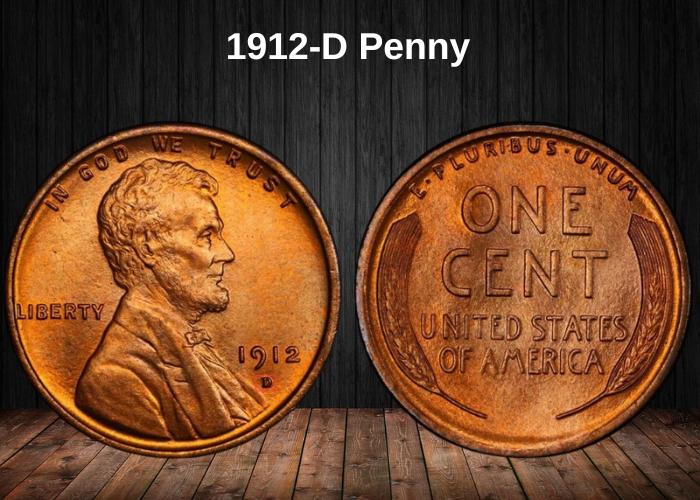
In 1912, the US Mint produced 10,411,000 pennies in Denver. These were all business strikes (regular strikes) intended for circulation, and each coin was marked with the D Mint Mark.
The value of these coins, particularly in higher grades, has increased over time:
- In November 2017, a 1912 D MS 66 BN (Brown) penny sold for $1,540. As of 2025, PCGS estimates the value of this coin at around $1,800.
- A 1912 D MS 65 RB (Red-Brown) penny was sold for $1,400 on eBay in 2022, although PCGS currently values it at $1,000, as nearly 30 of these coins have been submitted for grading.
- For 1912 D MS 65 RD (Red), PCGS sets the value at $1,200, while a MS 66 RD (Red) can fetch around $6,000.
- In the red category, the value of MS 66 RD pennies has decreased over time. For instance, one was sold for $34,500 in May 2005, but its value has since dropped to around $6,000 by 2025, largely due to the fact that almost 40 have been graded at this level.
- A step up from MS 66 RD, MS 66+ RD pennies (around 12 in existence) are valued at $18,500.
- The most expensive penny from this series is the 1912 D MS 67 RD, which can reach $70,000 due to its rarity in this grade.
These price variations demonstrate the importance of coin quality and scarcity, which can significantly influence their resale value in the numismatic market.
1912-S Penny Value
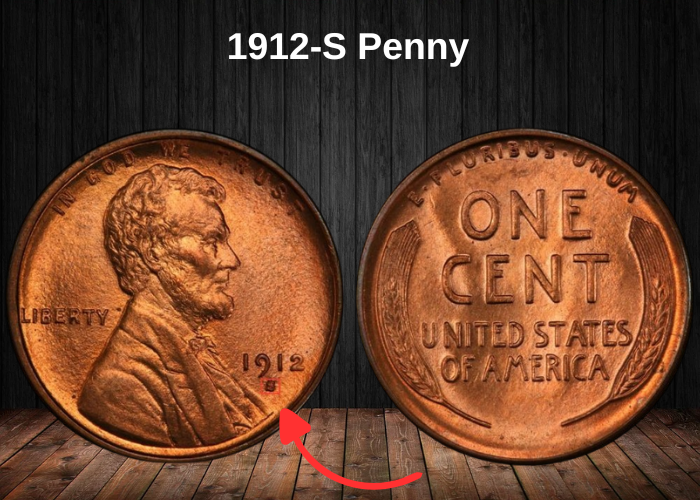
In 1912, the San Francisco Mint produced 4,431,000 pennies for circulation, all marked with the “S” Mint Mark. Over time, these older coins have been graded differently, depending on their condition. For example, a “Choice Brilliant Uncirculated” (CH BU) coin, often equating to an MS 63 grade, sold for $2,530 in May 1999. An MS 65 RB was valued at $5,175 in 2005, but its value has since decreased to around $1,300, as more than 70 have been graded by PCGS.
For red coins, an MS 65 RD penny was worth $27,600 in May 2003, but its price has dropped to $2,500 in January 2025, with over 80 specimens being submitted. However, there are slightly more than a dozen MS 65+ RD and MS 66 RD pennies, with current values of $3,100 and $18,000, respectively.
1912 No Mint Mark Penny Value
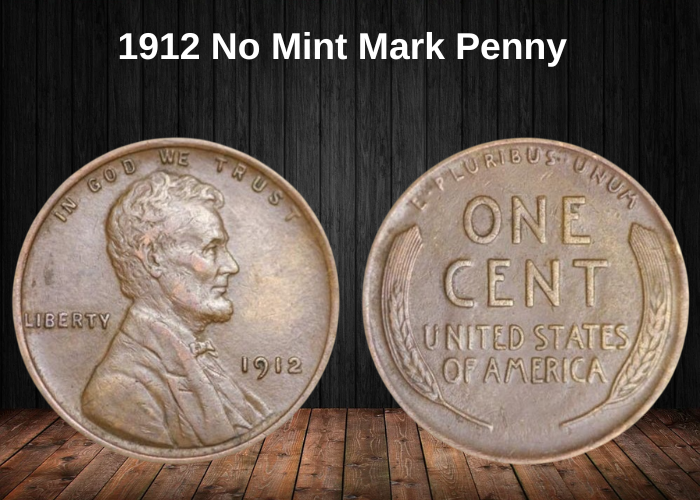
In 1912, the Philadelphia Mint produced 68,150,915 Wheat Cents, all without a mint mark. While brown pennies typically don’t hold much value, these coins are now over a century old, and even those in lower grades can still be valuable. For instance, in February 2023, an eBay seller sold a 1912 (P) MS 65 BN Penny for $559, but given that nearly 40 coins in this grade have been submitted to PCGS, their value is estimated at $275 for January 2025. The value for an MS 65+ BN is expected to be $300, and an MS 66 BN will be worth about $375.
For red-brown coins, an MS 66 RB sold for $576 in September 2022. However, with only ten coins of this grade submitted to PCGS, they are expected to be worth $550 in January 2025. The sole known MS 67 RB penny is valued at $5,000.
For red coins, an MS 67 RD penny sold for $21,850 in August 2006. With around fifteen coins of this grade known to PCGS, their value has dropped to $5,350 as of January 2025. However, only three MS 67+ RD coins are known, and these are expected to be worth $35,000 each in 2025. Meanwhile, MS 66 RD pennies, with over a hundred coins rated at this grade, are valued at $1,300, and MS 66+ RD coins, numbering about twenty, are estimated at $2,450.
1912 Proof No Mint Mark Penny Value
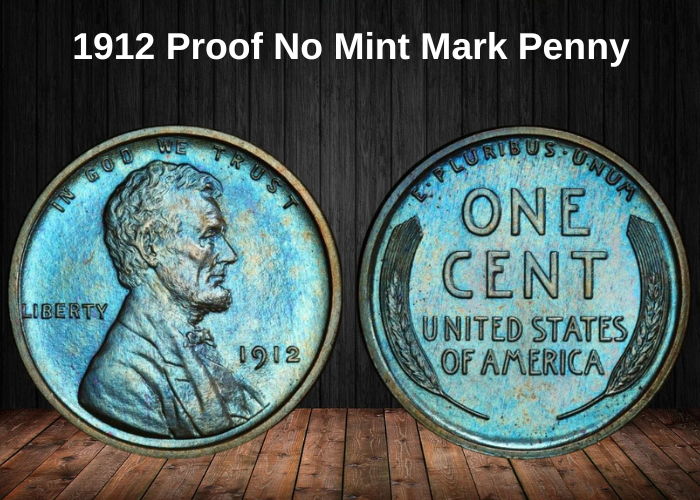
One of the key characteristics of the Lincoln Cent was its curved surface, which posed challenges for producing mirror-like proof pennies. To solve this, the U.S. Mint began creating sandblasted pennies, often referred to as matte proofs or satin finish coins. Both the die and the planchet were sandblasted to give the coins a noticeable grainy texture. Afterward, the coins were stored in tissue paper infused with sulfur, designed to prevent tarnishing.
Although the sulfur-infused paper didn’t always prevent tarnishing, it did give the coins a unique toning that was highly sought after, enhancing their value. Matte proofs can be identified by their square rims and sharp, crisp details. To achieve this, the Mint used extra pressure on the dies and retired them more quickly to maintain the clarity of the design.
1912 Matte Proof Penny Values
In 1912, the Philadelphia Mint produced 2,145 Matte Proof Pennies without mint marks. A PR 67 BN penny was sold for $9,500 on eBay in 2018. Since then, only two additional coins have been discovered, meaning the current value of these three coins is estimated at $7,250 each as of 2023. A PR 66+ RB penny sold for $14,100 in August 2014, and with five known examples, their value is now estimated at $12,000.
For PR 67 RBs, the value is harder to pin down as PCGS has not graded any yet, but NGC has sold them for prices ranging from $1,000 to $3,500. On the higher end of the spectrum, a PR 66 RD sold for $37,600 in February 2016. Since PCGS has graded three examples at this level, they estimate their value at $30,000 in September 2023. NGC sales have seen a wider range, with PR 66 RDs fetching anywhere from $9,000 to $25,000.
Rare 1912 Penny Errors List
The minting process can produce hundreds of coins per minute, so some errors are inevitable. These mint mistakes can actually increase a coin’s value, as collectors often seek out first-strike errors within the first month of a coin’s release. These errors are assigned FS (First Strike) numbers to identify them. While the 1912 Penny didn’t have any FS errors, collectors should still be on the lookout for other types of flaws, such as wrong planchets, cud breaks, or die clashes, which can significantly affect the coin’s value.
1912-S/S Penny RPM Error
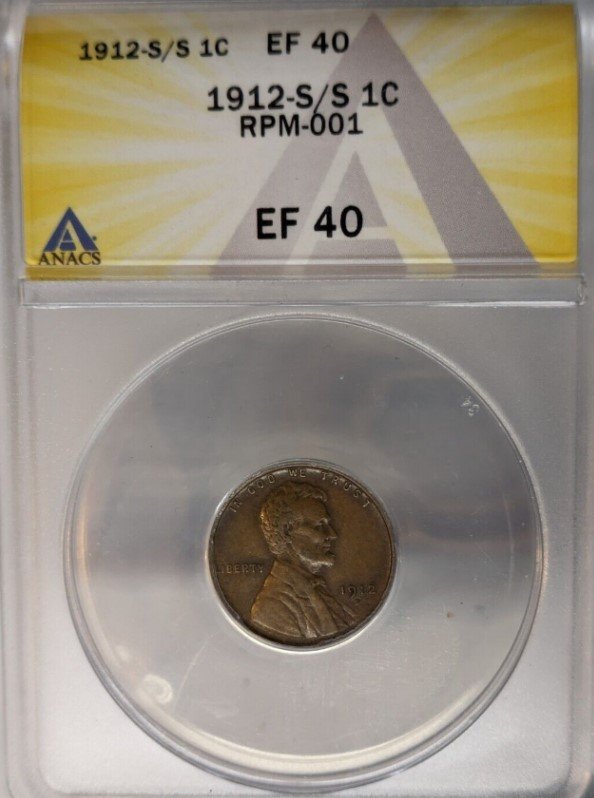
RPM stands for re-punched mint mark. In the early days of coin minting, the mint mark was added to the die as the final step, and it was done by hand. This manual process made it prone to errors, such as doubling, if the person punching the mint mark wasn’t precise. The second strike might land slightly off to the left or right, resulting in remnants of the earlier mint mark being visible beneath the new one. For example, a VF 35 penny with an RPM sold for $46 in 2018.
1912-S Penny Inconsistent Obverse Strike Error
Due to budget cuts at the mint, dies were often used for extended periods beyond their optimal lifespan. As a result, coins can be categorized into two groups: EDS (Early Die State) and LDS (Later Die State). In the case of San Francisco Pennies, some LDS coins display a softer strike on the right side, which causes those areas of the coin to wear down faster. This often results in blurriness, especially on the “2” in the year “1912” and the “US” in “In God We Trust.” Additionally, the final “T” in “Trust” is frequently missing on these later die state coins.
1912-D Penny Over-Polished Late Die State
The difference between EDS (Early Die State) and LDS (Later Die State) pennies is also noticeable on Denver Mint coins. On LDS pennies from Denver, it’s common to see mild die cracks, which are a result of the dies starting to wear out. In some cases, the mint would re-polish the dies to try to restore clarity to the design details. However, this polishing can lead to erosion on specific areas, particularly the lower right of the coin, affecting the rim, Lincoln’s neck, and his lapel. The lettering on LDS coins can also appear bloated or uneven, with “Liberty” and “God We” being particularly noticeable.
Where to sell your penny?
Now that you know the value of your penny, you might be wondering where to sell it. Don’t worry: here’s a guide to some of the best online platforms where you can easily sell your coins, along with their advantages and disadvantages.
Discover the best platforms for selling coins online (pros and cons).
1912 Penny FAQ
How Many Pennies Were Made in 1912?
In 1912, a total of 82,997,205 pennies were produced across the three mint branches: San Francisco, Denver, and Philadelphia. This total includes 2,145 matte proof pennies that were minted in Philadelphia.
What is the 1912 Penny Made Of?
The 1912 penny is made of French bronze, which consists of 95% copper and 5% zinc, tin, or a combination of both metals.



















































